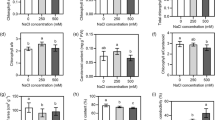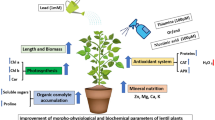Abstract
Sheepgrass [Leymus chinensis (Trin.) Tzvel] is a valuble forage plant highly significant to regional grassland productivity of Euro-Asia steppes. Although effects of environmental stress including drought have been studied, impact of nutrient deficiency in particular phosphate (Pi), one of the essential macronutrient, is not reported. Here, we investigated low-Pi effect on its photosynthetic apparatus via physiological and biochemical analysis. We show that PSII activity was significantly reduced based on chlorophyll fluorescence measurements. We observed decreased amount of core proteins of PSII by immunoblot analysis. Further analysis of thylakoid membranes using 2D-BN/SDS-PAGE and immunoblot detection demonstrated that the amount of PSII complexes was closely correlated with the Pi levels within the range. Together with reduced number of thylakoid grana stackings observed, we suggest that the maintenance of PSII is impaired under Pi-limited condition. Moreover, enzyme activity assays revealed that the activity of several ROS scavenger enzymes was stimulated by low-Pi treatment. Based on these experimental results we conclude that PSII is the component of photosynthetic apparatus most sensitive to Pi supply and the enhanced anti-ROS activity is mainly subjective to protection of PSII against low Pi-induced photo-oxidative stress in the organism.
Similar content being viewed by others
References
Arnon DI (1949) Copper enzymes in isolated chloroplasts. Polyphenoloxidase in Beta vulgaris. Plant Physiol 24:1–15
Bai YF, Han XG, Wu JG, Chen ZZ, Li LH (2004) Ecosystem stability and compensatory effects in the Inner Mongolia grassland. Nature 431:181–184
Beauchamp C, Fridovich I (1971) Superoxide dismutase: improved assays and an assay applicable to acrylamide gels. Anal Biochem 44:276–287
Caverzan A1, Bonifacio A, Carvalho FE, Andrade CM, Passaia G, Schünemann M, Maraschin Fdos S, Martins MO, Teixeira FK, Rauber R, Margis R, Silveira JA, Margis-Pinheiro M (2014) The knockdown of chloroplastic ascorbate peroxidases reveals its regulatory role in the photosynthesis and protection under photooxidative stress in rice. Plant Sci 214:74–87
Che YF, Fu AG, Hou X, McDonald K, Buchanan BB, Huang WD, Luan S (2013) C-terminal processing of reaction center protein D1 is essential for the function andassembly of photosystem II in Arabidopsis. Proc Natl Acad Sci USA 110:16247–16252
Chen L, Zhang S, Zhao H, Korpelainen H, Li C (2010) Sex-related adaptive responses to interaction of drought and salinity in Populus yunnanensis. Plant Cell Environ 33:1767–1778
Chen S, Huang X, Yan X, Liang Y, Wang Y, Li X, Peng X, Ma X, Zhang L, Cai Y, Ma T, Cheng L, Qi D, Zheng H, Yang X, Li X, Liu G (2013) Transcriptome analysis in sheepgrass (Leymus chinensis): a dominant perennial grass of the Eurasian Steppe. PLoS One 8:e67974
Chiou TJ, Lin SI (2011) Signaling network in sensing phosphate availability in plants. Annu Rev Plant Biol 62:185–206
Delhaize E, Randall PJ (1995) Characterization of a phosphateaccumulator mutant of Arabidopsis thaliana. Plant Physiol 107:1207–1213
Fischer K, Kammerer B, Gutensohn M, Arbinger B, Weber A, Häusler RE. Flügge UI (1997) A new class of plastidic phosphate translocators: a putative link between primary and secondary metabolism by the phosphoenolpyruvate/phosphate antiporter. Plant Cell 9:453–462
Fredeen AL, Rao IM, Terry N (1989) Influence of phosphorus nutrition on growth and carbon partitioning in Glycine max. Plant Physiol 89:225–230
Fredeen AL, Raab TK, Rao IM, Terry N (1990) Effects of phosphorus nutrition on photosynthesis in Glycine max (L.) Merr. Planta 181:399–405
Hamburger D, Rezzonico E, Petetot JMC, Somerville C, Poirier Y (2002) Identification and characterization of the Arabidopsis PHO1 gene involved in phosphate loading to the xylem. Plant Cell 14:889–902
Han WX, Fang JY, Guo DL, Zhang Y (2005) Leaf nitrogen and phosphorus stoichiometry across 753 terrestrial plant species in China. New Phytol 168:377–385
Hernández I, Munné-Bosch S (2015) Linking phosphorus availability with photo-oxidative stress in plants. J Exp Bot 66:2889–2900
Hoagland DR, Arnon DI (1950) The water culture method for growing plants without soil. California Agricultural Experiment Station, Circular 347:4–32
Hodges DM, DeLong JM, Forney CF, Prange RK (1999) Improving the thiobarbituric acid-reactive-substances assay for estimating lipid peroxidation in plant tissues containing anthocyanin and other interfering compounds. Planta 207:604–611
Laemmli UK (1970) Cleavage of strutural proteins during the assembly of the head of bacteriophage T4. Nature 227:680–685
Lei L, Li Y, Wang Q, Xu J, Chen Y, Yang H, Ren D (2014) Activation of MKK9-MPK3/MPK6 enhances phosphate acquisition in Arabidopsis thaliana. New Phytol 203:1146–1160
Li XL, Liu ZY, Wang Z, Wu XH, Li XL, Hu J, Shi HX, Guo FH, Zhang Y, Hou XY (2015) Pathways of Leymus chinensis individual aboveground biomass decline in natural semiarid grassland induced by overgrazing: A study at the plant functional trait scale. PLoS ONE 10:e0124443
Liu ZP, Chen ZY, Pan J, Li X, Su M, Wang L, Li H, Liu G (2008) Phylogenetic relationships in Leymus (Poaceae: Triticeae) revealed by the nuclear ribosomal internal transcribed spacer and chloroplast trnL-F sequences. Mol Phylogenet Evol 46:278–289
López-Arredondo DL, Leyva-González MA, González-Morales SI, López-Bucio J, Herrera-Estrella L (2014) Phosphate nutrition: improving low-phosphate tolerance in crops. Annu Rev Plant Biol 65:95–123
Møller IM, Jensen PE, Hansson A (2007) Oxidative modifications to cellular components in plants. Annu Rev Plant Biol 58:459–481
Munekage Y, Hojo M, Meurer J, Endo T, Tasaka M, Shikanai T (2002) PGR5 is involved in cyclic electron flow around photosystem I and is essential for photoprotection in Arabidopsis. Cell 110:361–371
Peng LW, Shimizu H, Shikanai T (2008) The chloroplast NAD(P)H dehydrogenase complex interacts with photosystem I in Arabidopsis. J Biol Chem 283:34873–34879
Peterson G L (1977) A simplification of the protein assay method of Lowry et al. which is more generally applicable. Anal Biochem 83:346–356
Raghothama KG, Karthikeyan AS (2005) Phosphate acquisition. Plant Soil 274:37–49
Rochaix JD (2011) Assembly of the photosynthetic apparatus. Plant Physiol 155:1493–1500
Rubio V, Linhares F, Solano R, Martín AC, Iglesias J, Leyva A, Paz Ares J (2001) A conserved MYB transcription factor involved in phosphate starvation signaling both in vascular plants and in unicellular algae. Gene Dev 15:2122–2133
Schachtman DP, Reid RJ, Ayling S (1998) Phosphorus uptake by plants: from soil to cell. Plant Physiol 116:447–453
Siripornadulsil S, Traina S, Verma DPS, Sayre RT (2002) Molecular mechanisms of proline-mediated tolerance to toxic heavy metals in transgenic microalgae. Plant Cell 14:2837–2847
Trevisan MTS, Scheffer JJC, Verpoorte R (1997) Effect of elicitation on the peroxidase activity in some cell suspension cultures of hop, Humulus lupulus. Plant Cell Tiss Org 48:121–126
Usuda H, Shimogawara K (1992) Phosphate deficiency in maize: III. changes in enzyme activities during the course of phosphate deprivation. Plant Physiol 99:1680–1685
Wang L, Li Z, Qian W, Guo W, Gao X, Huang L, Wang H, Zhu H, Wu JW, Wang D, Liu D (2011) The Arabidopsis purple acid phosphatase AtPAP10 is predominantly associated with the root surface and plays an important role in plant tolerance to phosphate limitation. Plant Physiol 157:1283–1299
Wu P, Ma LG, Hou XL, Wang MY, Wu YR, Liu FY, Deng XW (2003) Phosphate starvation triggers distinct alterations of genome expression in Arabidopsis roots and leaves. Plant Physiol 132:1260–1271
Wykoff DD, Davies JP, Melis A, Grossman AR (1998) The regulation of photosynthetic electron transport during nutrient deprivation in Chlamydomonas reinhardtii. Plant Physiol 17:129–139
Xu ZZ, Zhou GS (2006) Combined effects of water stress and high temperature on photosynthesis, nitrogen metabolism and lipid peroxidation of a perennial grass Leymus chinensis. Planta 224:1080–1090
Yang HM, Liao LB, Bo TT, Zhao L, Sun XW, Lu XF, Norling B, Huang F (2014) Slr0151 in Synechocystis sp. PCC 6803 is required for efficient repair of photosystem II under high-light condition. J Integr Plant Biol 56:1136–1150
Zhang K, Liu H, Tao P, Chen H (2014) Comparative proteomic analyses provide new insights into low phosphorus stress responses in maize leaves. PloS One 9:e98215
Zhang ZL, Liao H, Lucas WJ (2014) Molecular mechanisms underlying phosphate sensing, signaling, and adaptation in plants. J Integr Plant Biol 56:192–220
Zhao L, Chen M, Cheng DM, Yang HM, Sun YL, Zhou H, Huang F (2013) Different B-type methionine sulfoxide reductases in Chlamydomonas may protect the alga against high-light, sulfurdepletion or oxidative stress. J Integr Plant Biol 55:1053–1067
Zhou J, Jiao FC, Wu ZC, Li YY, Wang XM, He XW, Zhong WQ, Wu P (2008) OsPHR2 is involved in phosphate-starvation signaling and excessive phosphate accumulation in shoots of plants. Plant Physiol 146:1673–1686
Author information
Authors and Affiliations
Corresponding author
Additional information
These authors contributed equally to this work.
Electronic supplementary material
Rights and permissions
About this article
Cite this article
Li, L., Yang, H., Ren, W. et al. Physiological and biochemical characterization of sheepgrass (Leymus chinensis) reveals insights into photosynthetic apparatus coping with low-phosphate stress conditions. J. Plant Biol. 59, 336–346 (2016). https://doi.org/10.1007/s12374-016-0117-1
Received:
Accepted:
Published:
Issue Date:
DOI: https://doi.org/10.1007/s12374-016-0117-1




